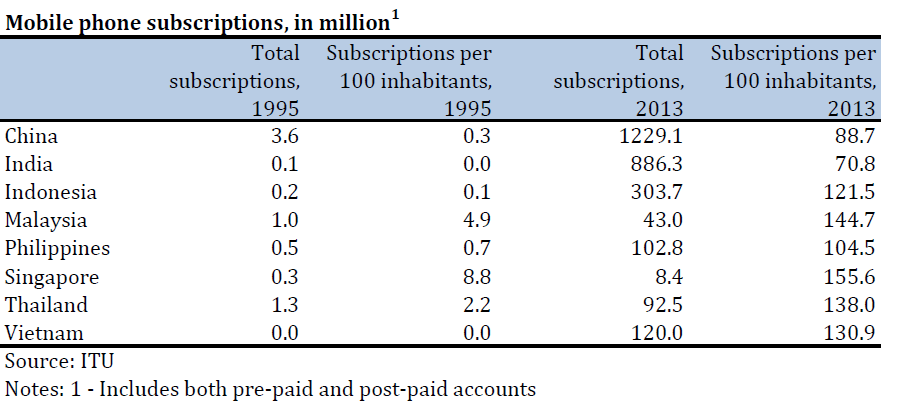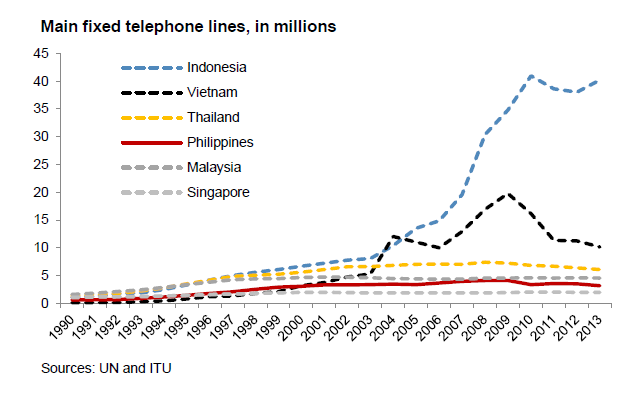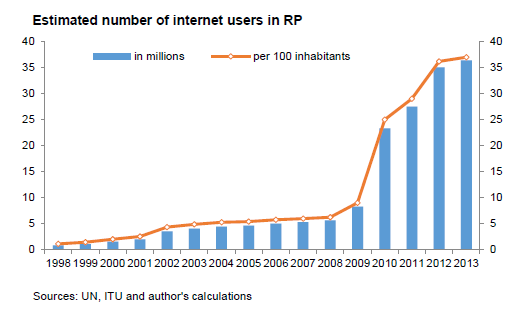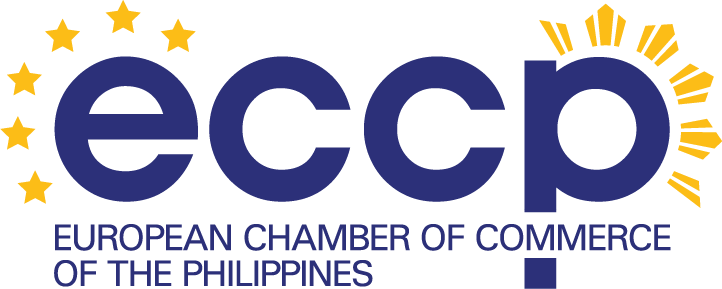Background (Telecommunications)
Sector Background and Potential
Modern telecommunications and information technology infrastructure are vital to the economic growth of the Philippines, serving multifarious purposes in daily life and enabling the rapid growth of the BPO sector, as well as enhancing the economy’s overall efficiency.115 Land lines, mobile telephones, Internet, and various cable and satellite technologies that carry voice and data connect Filipinos and foreigners alike, within the archipelago and around the globe. In recent years, Filipinos – including presidential candidates – have even become heavy users of social media communications.116
In a country where change comes slowly, reform in telecommunications during the last 15 years has occurred very quickly. In only a decade, Philippine telecommunications advanced from a backward, monopolistic, high-cost, and inefficient public utility to a sector with considerable competition, enabling a majority of the population to communicate at home and abroad at much reduced cost.
Almost 18 years ago former Singapore Prime Minister Lee Kuan Yew, addressing the annual PCCI business conference in Manila, commented “in the Philippines, 98% of the population is waiting for a telephone, while the rest are waiting for a dialling tone.” More than a decade later, a majority of Filipinos have both.
In one of the most consequential reforms initiated by former President Ramos, the control of Philippine Long Distance Telephone Company (PLDT) of Philippine domestic and international telecommunications was broken in 1993 by two executive orders, one mandating interconnection and the other requiring phone companies (in addition to PLDT) to install specified numbers of landlines and cellphones in their assigned areas. The executive orders were followed two years later by Congressional passage of a telecommunications reform law.
Today two large and two smaller companies are active in the local telecommunications market. All four companies provide mobile and landline telephone service as well as Internet broadband. Each holds a public utility franchise granted by Congress, as required under the colonial era Public Utilities Act. Their foreign partners have invested substantial equity in the sector.
In addition to increased competition and consumer choice, another critical factor in the country’s improved telecommunications infrastructure has been rapid technological change. Landlines have been overtaken by mobile phones, and postpaid telephone accounts by prepaid. Today Filipinos have twenty times as many mobile subscriptions as landlines. The Philippines, called the text message capital of the world, is the world leader in Short Messaging Service (SMS) with almost one billion daily messages.117
While the country lags in many competitiveness indicators, mobile phone penetration is not among them. In 2009 the penetration rate per 100 inhabitants of the Philippines (81) was higher than China (56), India (44), and Indonesia (69), while lower than Malaysia (110), Singapore (140), Thailand (123), and Vietnam (101) (see Table 42).
Digital fiber connects the Philippines inexpensively to the far corners of the globe, providing what American columnist Tom Friedman once termed the equivalent of an oil pipeline moving services of skilled Filipino workers to North American markets. The newest Voice over Internet Protocol (VoIP) telephone service via computers has brought the cost of communicating on the Internet almost to zero.
As the cost of accessing the Internet falls, the next new technology for the Philippines is the high-speed wireless broadband revolution. Although less than 5% of mobile phones in the Philippines have 3G today, within a few years many millions more could have cheap Internet access on their cellphones. In Asia, 3G penetration already exceeds 50% in Australia, Hong Kong, Japan, Korea, and Singapore.118 One presidential candidate in 2010 suggested providing Filipino students with mobile digital reading devices, a visionary yet highly practical proposal.119
The benefit for national competitiveness of these changes will be enormous. Most Filipinos will be able to avail of global SMS and email communications on mobile devices. They will “leap over” the relatively low household computer penetration in the Philippines of 13% (see Figure 91).
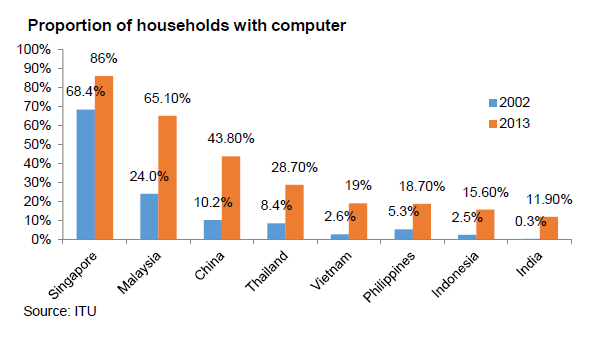 View original figure here
View original figure hereThe following provides a brief overview of the four major telecommunication companies in the country. The public sector role in the sector is limited to regulation through the National Telecommunications Commission (NTC).
Philippine Long Distance Telephone Company
Established by an act of Congress in 1928, 80-year old PLDT is the country’s largest telecommunication company, measured by its annual revenue (PhP 147 billion in 2009) and subscribers (41 million cellphone subscribers with Smart and 1.8 million landline subscribers).120 PLDT is one of the country’s largest firms in terms of total revenue. In addition, PLDT is one of the largest BPO providers in the Philippines, with smaller operations in China, Europe, India, the US, and Vietnam.121
Over a half-century, ownership of PLDT has changed from majority American then Filipino and now Filipino-Hong Kong-Japanese. Its shares have been traded on the New York Stock Exchange (NYSE) since before WWII. The current principal owner, First Pacific Company Ltd (Hong Kong), whose shares trade separately on American stock exchanges, is principally owned by the Salim family, once Indonesia’s largest business conglomerate. PLDT lists its ownership structure as including the First Pacific Group (26%) and NTT (Japan) (21%).122
Since WWII, the style of management of PLDT and the business environment in which the company operates have changed significantly. First, PLDT was an American-owned public utility. In the mid-1960s, ownership and management became closely allied with the interests of business allies of then-president Marcos. Since 1998, new ownership has changed PLDT into an Asian-owned joint venture company. Management behavior has shifted from rent-seeking to dynamic competition, following sectoral reforms initiated by former president Ramos. The wait for a new landline is now weeks, not years, and most subscribers no longer want this older technology.
Globe Telecom Inc.
The second largest Philippine telecommunications firm, Globe, with revenues of PhP 62 billion in 2009 and over 23 million subscribers, is a joint venture between Ayala Corporation (Filipino) and Singapore Telecommunications.123 SingTel currently owns 47% while Ayala Corporation holds 31% with the remaining 22% shared by public investors.124 SingTel, one of the largest telecommunications company in Asia outside the PRC, is majority-owned by Temasek Holdings, the investment company of the Singapore Government, whose total assets exceed US$ 100 billion.
Like PLDT, Globe’s franchise originated before WWII, in a 1928 law which granted a California-based American investor a franchise to operate wireless long distance message services, first named Globe Wireless Limited and later Globe Mackay Cable and Radio Corporation. In 2000, Globe merged with Islacom, and its principal foreign shareholder, a subsidiary of Deutsche Telekom AG, exited the country.
Beginning in the early 1990s, Globe began to grow market share by aggressively lowering prices. When Globe stopped lowering its prices, tariffs for all international calls had fallen to US$ 0.40 a minute from over US$ 3.00 a minute. Globe steadily gained market share through its price lowering strategy.125
LiveIt, a sister company in the Ayala Group, invests in IT service providers. Its largest acquisition in October 2008 took NASDAQ-traded eTelecare private for US$ 270 million.126 In 2009 eTelecare merged with Stream Global Services (US), one of the largest global call center operators with 50 sites and nearly US$ 1 billion in annual revenue. Integreon, another unit of LiveIt, in May 2010 signed a 10-year contract worth US$ 852 million to provide legal research and related office services to a UK law firm.
Digitel Telecommunications Philippines
The third firm Digitel commenced operations in 1992 to take advantage of the opening of the sector under President Ramos. By 2009, Digitel earned PhP 14 billion in total revenue from 13 million subscribers. Digitel’s primary shareholder is JG Summit Group of the Gokongwei family (48%), one of the largest Filipino-Chinese conglomerates. TeliaSonera AB, the dominant telephone company and mobile network operator in Sweden and Finland, owns 9%.127
The Gokongwei group acquired and expanded an existing poorly-managed government telephone network, later obtaining a national franchise from Congress and adding mobile services. The DOTC awarded Digitel a 30-year contract to manage telecommunications systems owned by DOTC on Luzon. Later the contract was converted to a lease with the right to eventually own the government network. Digitel launched its wireless mobile services in 2003 under the Sun Cellular brand. It sought to gain subscribers with a 24/7 unlimited call and SMS set price subscription for Sun-to-Sun connections. Its two larger competitors responded with similar but higher-priced plans.
Bayan Telecommunications
BayanTel, the telecommunications sector venture of the Lopez Group, was first incorporated in 1961 as International Communications Corporation. It holds a public utility franchise and operates largely in Metro Manila and Bicol. BayanTel is 85% owned by the Lopez Group and sister firm Benpres with Asian Infrastructure Fund (AIF) – a foreign private equity fund – as the other major shareholder.128 The company has struggled to gain market share. Its senior officer is a foreign national who carries the title Chief Executive Consultant (CEC). Philippine law requires that senior officers of public utility corporations be Filipino.
Currently, the Philippine telecommunication sector is highly competitive. Foreign capital needed to expand and modernize the sector has readily been available from equity, corporate debt, and bank loans. Exceeding the 40% limit on foreign equity by the two largest providers (while observing the Control Test) could be a precedent for future formal lifting of this limit should the current constitutional restrictions be removed. More entrants into the market should bring some additional downward pressure on prices to the benefit of consumers and reduced business costs.
Meanwhile, the Internet has greatly reduced telecommunication, postage, and courier costs for businesses. Email and VOIP allow voice communication, document, and other data transfer at little or no expense. Given the high capital costs required for market entry, future new entrants may find takeover of an existing operator an attractive option.
Table 43 shows four indicators of access to information and communication technology for the ASEAN-6 economies plus China and India. The table shows the Philippines was able to skip over the great expense of installing large numbers of landlines (where its penetration remains low) going straight to mobile telephones (where penetration is relatively high). The Philippines has a low level of Internet penetration (6.5 per 100 inhabitants) and a comparable level of computer penetration (21% of households) relative to Indonesia (8.7% and 6.4%) and Vietnam (27.3% and 10.2%) but not Malaysia (57.6% and 38.7%) and Thailand (25.8% and 19.6%). There is a tremendous upside for growth in both.
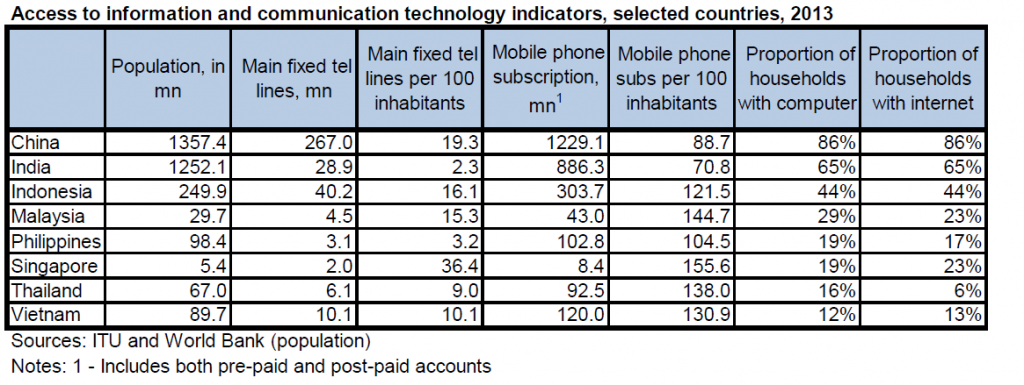
View original table here
Figures 92, 93, 94, 95, 96, and 97 present data on fixed and mobile telephone lines for the ASEAN-6 through 2008. The Philippines has the lowest penetration of fixed line subscribers per 100 inhabitants, while Vietnam has made a great leap upward increasing its penetration rate by around 1,000 percent in five years (see Figure 92). However, the Philippines did well with mobile phone penetration staying close to all the ASEAN-6 except Singapore and Malaysia. Penetration is Vietnam is rapidly increasing and has passed the Philippines (see Figure 95).
While billions of dollars have been invested by the private sector in mobile telephone infrastructure, there are still remote areas where coverage is weak or nonexistent or only covered by one provider. Some of these areas, such as Palawan, are popular tourist destinations, but are not commercially attractive to telecommunication companies. Fiscal or other incentives for capital investment for new cell sites can be used to encourage needed investment in these areas.
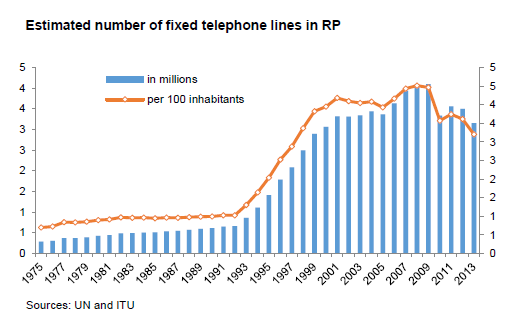 View original figure here
View original figure here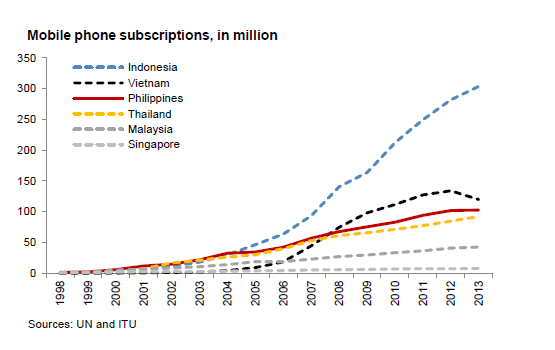 View original figure here
View original figure here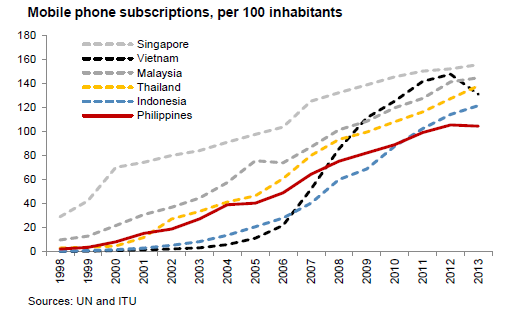 View original figure here
View original figure here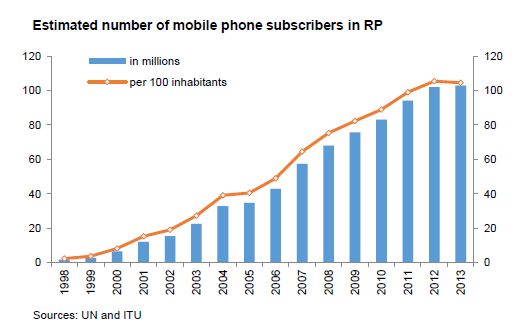 View original figure here
View original figure here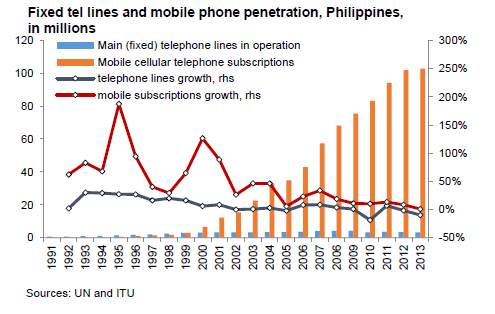 View original figure here
View original figure hereFigure 98 presents data on Internet use in the ASEAN-6. The Philippines has a low Internet penetration at 6.5 per 100 inhabitants, behind Indonesia (8.7) and far behind Thailand (25.8) and Vietnam (27.3), Malaysia (57.6), and Singapore (77.2)
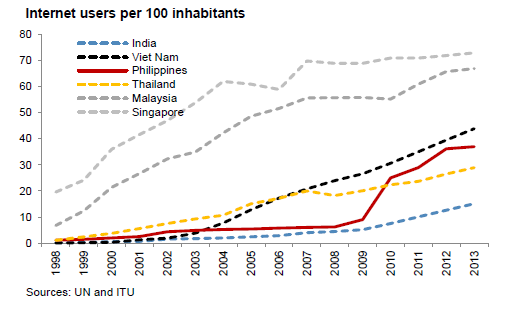 View original figure here
View original figure hereFigure 99 shows the number of Internet users in the ASEAN-6 and Figure 100 shows the number of Internet users in the Philippines. Only Singapore with its small population has fewer Internet users than the Philippines (6 million), and the rate of growth in the Philippines is much lower than the other ASEAN-6, except Singapore. The growth rate of Vietnam is extremely high; Vietnam now has almost four times as many Internet users as the Philippines.The low Internet penetration in the Philippines could be a function of poverty and poor education. Discussions by CICT and telecommunication providers with counterparts in the ASEAN-6 economies with higher penetration rates could learn more about programs that might be applied in the Philippines.
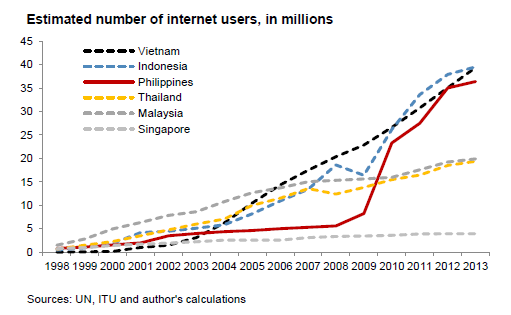 View original figure here
View original figure here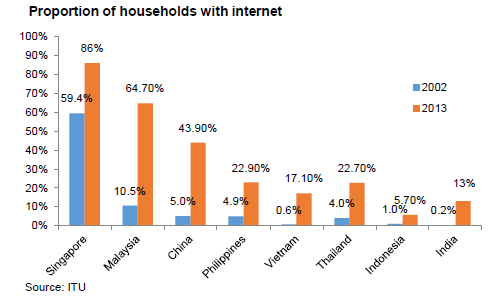 View original figure here
View original figure hereExpanded and higher speed broadband and higher computer penetration will bring a wealth of benefits to Filipinos and efficiencies for the economy, reducing business costs and helping the economy to become more competitive and meet its Millenium Development Goals. With mobile phone penetration in the country approaching 80%, new technology is available to link new generations of phones to the Internet on cellphones. This hybridization of mobile phones with computers is already happening in developed countries, where consumers are rapidly changing to reading digital books, magazines, and newspapers. Financial transactions are similarly facilitated over the Internet. Investing in such infrastructure is one of the most important actions in the near-term to increase Philippine competitiveness and move towards a knowledge-based service economy.Wireless Internet service is increasingly commercially available in most Philippine cities at various “hot spots.” A program to make free Wi-Fi available at national high schools and in densely populated urban areas can be considered as a means of encouraging greater use by Filipinos of new mobile technologies.
While the telecommunications industry in the Philippines has expanded considerably since deregulation, paving the way for local information technology related services to flourish, global ICT metrics suggest the country still has far to go to stay competitive in telecommunications with other developing countries in Asia.
The 2010 WEF Networked Readiness Index rankings show the Philippines ranks below 60% of more than 130 countries surveyed in terms of ICT infrastructure and preparedness in embracing a more technologically sophisticated system (see Table 44).129 It is also the only economy in the ASEAN-6 group to be ranked lower than over half of the total respondents according to the report. In particular, the country fared very low in terms of infrastructure environment and readiness of the government to modernize its entire structure. Burden of government regulation, length of procedures in starting a business, performance of legal institutions, education investment, and quality of research institutions are cited as major dampeners to its relative global position.
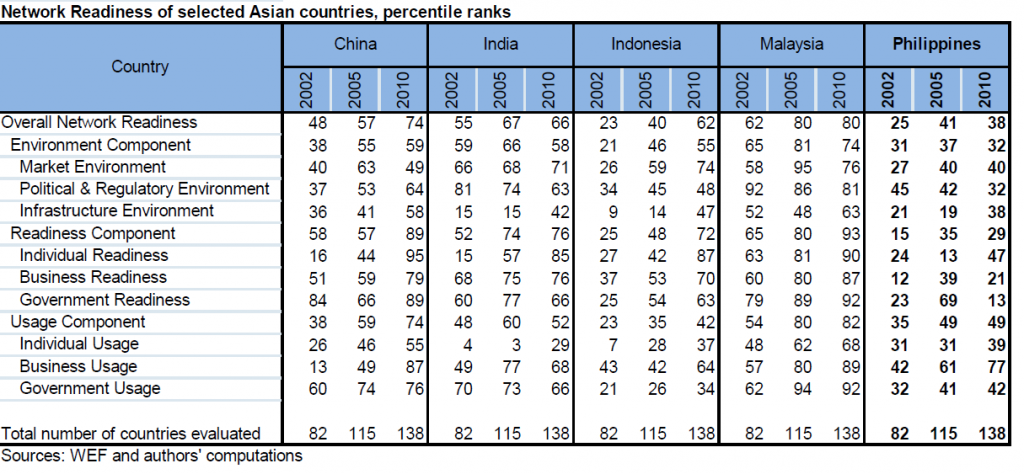
View original figure here
Another survey conducted by the United Nations showed that the Philippine world rankings concerning technological development to promote ease in government transactions and public service delivery have been declining in recent years (See Figure 102). Of the ASEAN-6, the Philippines ranks only above Vietnam and Indonesia, after being ranked just behind Singapore in 2002. The report showed the Philippine ranking is lower due to a poor telecommunications infrastructure component, while the human capital component was rated the highest.
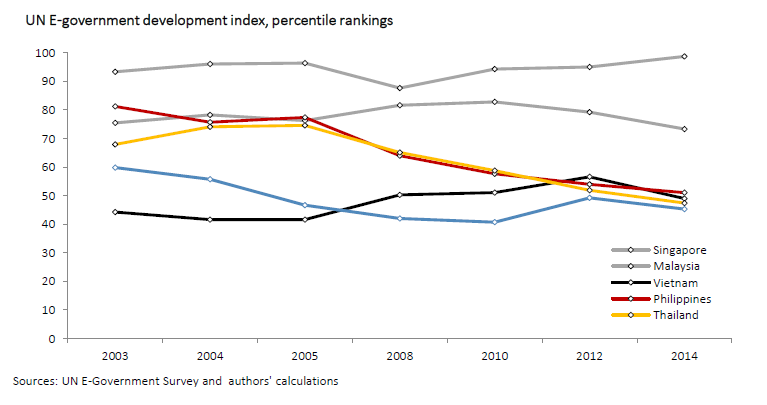 View original figure here
View original figure here“The public trust that is gained through transparency can be further enhanced through the free sharing of government data based on open standards. The ability of e-government to handle speed and complexity can also underpin regulatory reform. While technology is no substitute for good policy, it may give citizens the power to question the actions of regulators and bring systematic issues to the fore. Similary, e-government can add agility to public service delivery to help governments respond to an expanded set of demands even as revenues fall short… governments have made great strides in development of online services, especially in middle-income countries. The costs associated with telecommunication infrastructure and human capital continue to impede e-government development. However, effective strategies and legal frameworks can compensate significantly, even in least developed countries. Those who are able to harness the potential of expanded broadband access in developed regions and mobile cellular networks in developing countries… have much to gain forward.”
—2010 Global E-Government Survey, United Nations
Footnotes
- An FGD for Telecommunications and Information Technology was not held, although issues and recommendations relating to the BPO sector were discussed in the FGD on BPO. The Telecommunications and Information Technology section was drafted by the principal author of Roadmap 2010 and commented on by telecommunication experts in AmCham.[Top]
- Over 80% of the Philippine internet population uses social media networking sites. In Universal McCann’s 2008 Wave 3 study on social media, the Philippines had the highest penetration of social networking among Internet users at 83%, compared with the global average of 58%. In the 2010 election buildup, a politician expected to be a presidential candidate advertised heavily on Yahoo, the most popular email browser for Filipinos at home and overseas.There were 93.6 million Facebook users in Asia on August 31, 2010 (162.1 million in Europe and 149.1 million in North America). The top five Facebook countries in Asia are: Indonesia (27,338,560), Philippines (16,235,000), India (13,188,580), Malaysia (8,163,300), and Taiwan (7,052,660).Source: www.internetworldstats.com[Top]
- Source: Acision’s Press Release, “The Future is Messaging Growth,” September 7, 2008 (www.acision.com)[Top]
- Frost & Sullivan briefing, “Moving Beyond Messaging in the Philippines,” November 6, 2009[Top]
- Senator Richard Gordon authored this proposal. At least $2 billion could be required, a reasonable sum over a number of years if high-speed broadband wireless service is available.[Top]
- PLDT 2009 Annual Report[Top]
- Call center services are provided by ePLDT Ventus and BPO services by SPi Technologies, which together have more than 11,000 employees. Illustrative services include Content Editorial and Production, Content Coding, Abstracting and Indexing, Electronic Data Discovery, Content Transcription, Transaction Processing, Inbound Customer Care, Inbound Technical Support, Inbound Sales, Outbound Sales, Email support, and Website Maintenance.[Top]
- PLDT Notice and Agenda of Annual Stockholders Meeting, 2010[Top]
- Revenue and subscription data are from the Globe Telecom 2009 Annual Report. Ownership structure information was obtained from Globe Telecom’s website: www.globe.com.ph[Top]
- Asiacom owns all of the 158.5 million preferred shares (www.globe.com.ph)[Top]
- Sun, a late entrant mobile phone competitor, has gained substantial market share by following the same price lowering strategy.[Top]
- eTelecare is an excellent example of the growth of IT in the Philippines. Barely a decade old, it was started by two American consultants from Los Angeles who picked the Philippines over India to establish their first call center, joining with a company headed by a New Zealand entrepreneur. eTelecare was eventually bought by Ayala after it was spun off from SPI (which was eventually bought by PLDT). The cost of the two fast-growing firms was almost US$ 400 million in total, in light of their rapid, successful expansion in the Philippines. In 2009 eTelecare merged with Stream (US).[Top]
- Sources: Financial information – Digitel Telecommunications Philippines Inc’s SEC 2009 Annual Report; Number of subscribers – Lectura, Lenie. “Sun Cellular Subscribers top 13 million.” BusinessMirror. 25 May 2010.; Ownership structure (www.digitel.ph).[Top]
- Source: www.bayan.com.ph[Top]
- The framework aims to measure: (1) the degree to which a national environment is conducive to ICT development and diffusion, by taking into account a number of features of the broad business environment, some regulatory aspects, and the soft and hard infrastructure for ICT; (2) the extent to which the three main national stakeholders in a society (i.e., individuals, the business sector, and the government) are inclined and prepared to use ICT in their daily activities and operation; and (3) the actual use of ICT by the above three stakeholders. The NRI builds on a mixture of hard data collected by well-respected international organizations, such as the International Telecommunication Union (ITU), the United Nations, and the World Bank, and survey data from the Executive Opinion Survey, conducted annually by the Forum in each of the economies covered by the Report.[Top]











